IKEA Marketing Strategies: Segmentation, Targeting, and More
VerifiedAdded on 2020/10/22
|17
|4392
|102
Report
AI Summary
This report provides a comprehensive overview of marketing principles, strategies, and their practical application, particularly through the lens of the IKEA case study. The executive summary outlines the core concepts, including the 4Ps of marketing (product, place, pricing, promotion), segmentation, targeting, and positioning. The report delves into the elements of the marketing process, emphasizing customer satisfaction and the strategic importance of the 4Ps. It analyzes the benefits and costs of market orientation, using IKEA as a prime example, examining its global reach, financial performance, and commitment to sustainability. Furthermore, the report explores macro and micro-environmental factors, such as SWOT and PESTLE analyses, that influence marketing decisions. It examines market segmentation criteria, including measurability, sustainability, accessibility, differentiability, and action-based ability, and discusses the targeting strategies employed for specific products. Finally, the report analyzes buyer behavior in various purchasing situations and its effect on marketing activities.

Executive summary
The report summarizes the policies of marketing in terms of the marketing principles of
business based strategies and programmers of marketing in terms of some common principles of
marketing in terms of strategies or programmers of marketing in terms of certain policies like
that of 4P and product mix in terms of marketing, segmentation, targeting and other processes of
business marketing strategies in terms of organizational objectives and goals of business
procedures based plans .Segmentation and planning of strategies based on market based mix in
terms of segmentation of markets is another important policy of modern marketing strategy. The
differences between international marketing and domestic marketing are widely tested in terms
of superior business marketing strategy.
1
The report summarizes the policies of marketing in terms of the marketing principles of
business based strategies and programmers of marketing in terms of some common principles of
marketing in terms of strategies or programmers of marketing in terms of certain policies like
that of 4P and product mix in terms of marketing, segmentation, targeting and other processes of
business marketing strategies in terms of organizational objectives and goals of business
procedures based plans .Segmentation and planning of strategies based on market based mix in
terms of segmentation of markets is another important policy of modern marketing strategy. The
differences between international marketing and domestic marketing are widely tested in terms
of superior business marketing strategy.
1
Paraphrase This Document
Need a fresh take? Get an instant paraphrase of this document with our AI Paraphraser

2

Table of Contents
Introduction
The principles of marketing are based on several principles based on several concepts,
ideologies, processes, and environmental factor which do affect the marketing principles of
business organizations in varied amounts and patterns in terms of qualities. Per the author
(Schultz et al. 2013, p.12), the marketing policies and procedures are varied in amount and hence
their effects on marketing environmental scenario are differentiated and do differ in terms of
vagaries in lieu of different terms and conditions of business based methods and mechanisms.
The purpose of the thesis is to find out and analyze the detailed processes and concepts behind
marketing curriculum of business of latest or modern origin and find out and design efficient
strategies for dealing with marketing challenges.
Task 1 Understand the concept and process of marketing
1.1 Various elements of marketing process
Various elements of marketing process are based on the modern techniques adopted in
business organization. Marketing process depend on elements which attract customer satisfaction
and customer inclination towards the goods produced in business processes (Line and Bunyan,
2014, p.100). They are also being popularly known as 4P’s of business policies and procedures,
they are product, place, pricing and promoting. These elements of marketing are based on
modern day principles and norms of marketing. They are classified as follows;
3
Introduction
The principles of marketing are based on several principles based on several concepts,
ideologies, processes, and environmental factor which do affect the marketing principles of
business organizations in varied amounts and patterns in terms of qualities. Per the author
(Schultz et al. 2013, p.12), the marketing policies and procedures are varied in amount and hence
their effects on marketing environmental scenario are differentiated and do differ in terms of
vagaries in lieu of different terms and conditions of business based methods and mechanisms.
The purpose of the thesis is to find out and analyze the detailed processes and concepts behind
marketing curriculum of business of latest or modern origin and find out and design efficient
strategies for dealing with marketing challenges.
Task 1 Understand the concept and process of marketing
1.1 Various elements of marketing process
Various elements of marketing process are based on the modern techniques adopted in
business organization. Marketing process depend on elements which attract customer satisfaction
and customer inclination towards the goods produced in business processes (Line and Bunyan,
2014, p.100). They are also being popularly known as 4P’s of business policies and procedures,
they are product, place, pricing and promoting. These elements of marketing are based on
modern day principles and norms of marketing. They are classified as follows;
3
⊘ This is a preview!⊘
Do you want full access?
Subscribe today to unlock all pages.

Trusted by 1+ million students worldwide
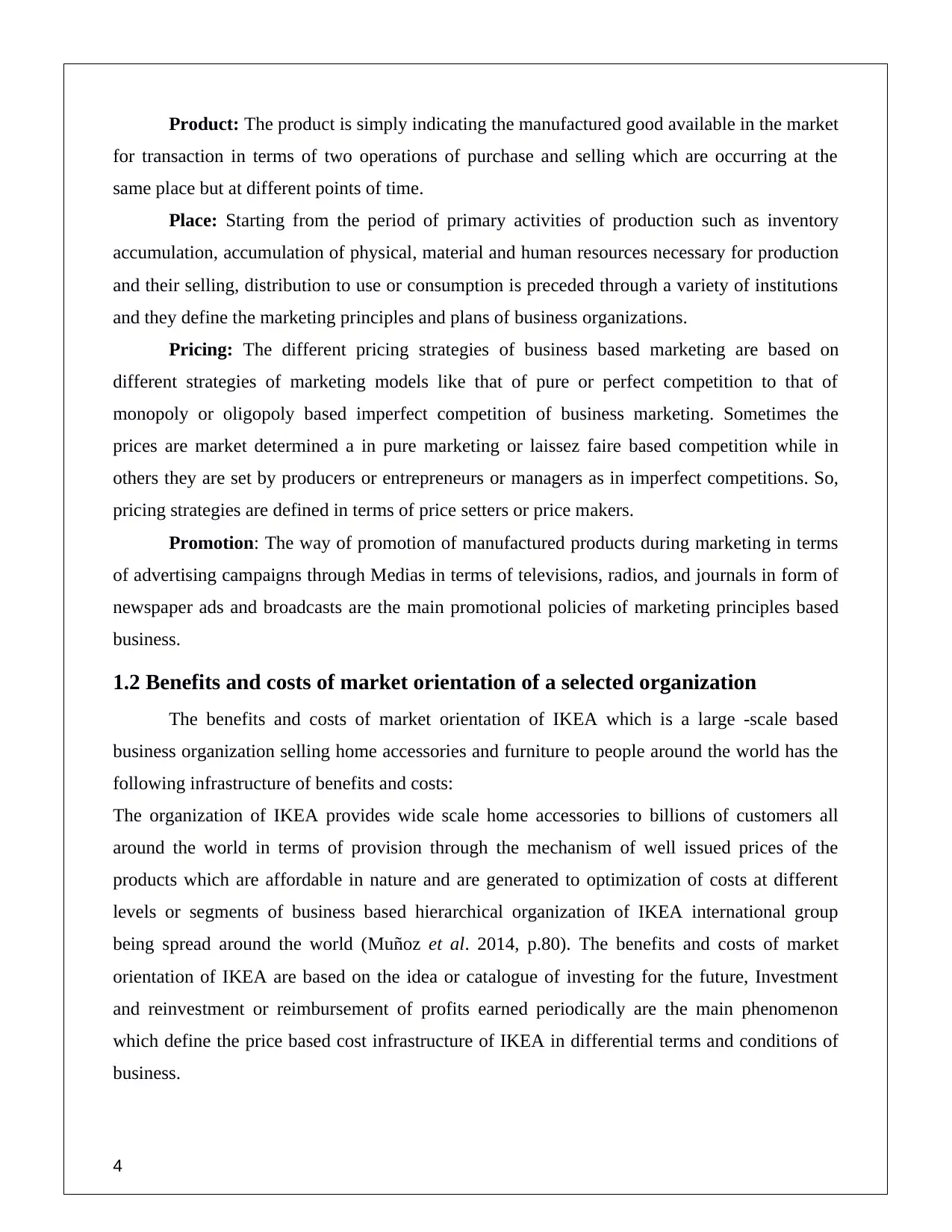
Product: The product is simply indicating the manufactured good available in the market
for transaction in terms of two operations of purchase and selling which are occurring at the
same place but at different points of time.
Place: Starting from the period of primary activities of production such as inventory
accumulation, accumulation of physical, material and human resources necessary for production
and their selling, distribution to use or consumption is preceded through a variety of institutions
and they define the marketing principles and plans of business organizations.
Pricing: The different pricing strategies of business based marketing are based on
different strategies of marketing models like that of pure or perfect competition to that of
monopoly or oligopoly based imperfect competition of business marketing. Sometimes the
prices are market determined a in pure marketing or laissez faire based competition while in
others they are set by producers or entrepreneurs or managers as in imperfect competitions. So,
pricing strategies are defined in terms of price setters or price makers.
Promotion: The way of promotion of manufactured products during marketing in terms
of advertising campaigns through Medias in terms of televisions, radios, and journals in form of
newspaper ads and broadcasts are the main promotional policies of marketing principles based
business.
1.2 Benefits and costs of market orientation of a selected organization
The benefits and costs of market orientation of IKEA which is a large -scale based
business organization selling home accessories and furniture to people around the world has the
following infrastructure of benefits and costs:
The organization of IKEA provides wide scale home accessories to billions of customers all
around the world in terms of provision through the mechanism of well issued prices of the
products which are affordable in nature and are generated to optimization of costs at different
levels or segments of business based hierarchical organization of IKEA international group
being spread around the world (Muñoz et al. 2014, p.80). The benefits and costs of market
orientation of IKEA are based on the idea or catalogue of investing for the future, Investment
and reinvestment or reimbursement of profits earned periodically are the main phenomenon
which define the price based cost infrastructure of IKEA in differential terms and conditions of
business.
4
for transaction in terms of two operations of purchase and selling which are occurring at the
same place but at different points of time.
Place: Starting from the period of primary activities of production such as inventory
accumulation, accumulation of physical, material and human resources necessary for production
and their selling, distribution to use or consumption is preceded through a variety of institutions
and they define the marketing principles and plans of business organizations.
Pricing: The different pricing strategies of business based marketing are based on
different strategies of marketing models like that of pure or perfect competition to that of
monopoly or oligopoly based imperfect competition of business marketing. Sometimes the
prices are market determined a in pure marketing or laissez faire based competition while in
others they are set by producers or entrepreneurs or managers as in imperfect competitions. So,
pricing strategies are defined in terms of price setters or price makers.
Promotion: The way of promotion of manufactured products during marketing in terms
of advertising campaigns through Medias in terms of televisions, radios, and journals in form of
newspaper ads and broadcasts are the main promotional policies of marketing principles based
business.
1.2 Benefits and costs of market orientation of a selected organization
The benefits and costs of market orientation of IKEA which is a large -scale based
business organization selling home accessories and furniture to people around the world has the
following infrastructure of benefits and costs:
The organization of IKEA provides wide scale home accessories to billions of customers all
around the world in terms of provision through the mechanism of well issued prices of the
products which are affordable in nature and are generated to optimization of costs at different
levels or segments of business based hierarchical organization of IKEA international group
being spread around the world (Muñoz et al. 2014, p.80). The benefits and costs of market
orientation of IKEA are based on the idea or catalogue of investing for the future, Investment
and reinvestment or reimbursement of profits earned periodically are the main phenomenon
which define the price based cost infrastructure of IKEA in differential terms and conditions of
business.
4
Paraphrase This Document
Need a fresh take? Get an instant paraphrase of this document with our AI Paraphraser
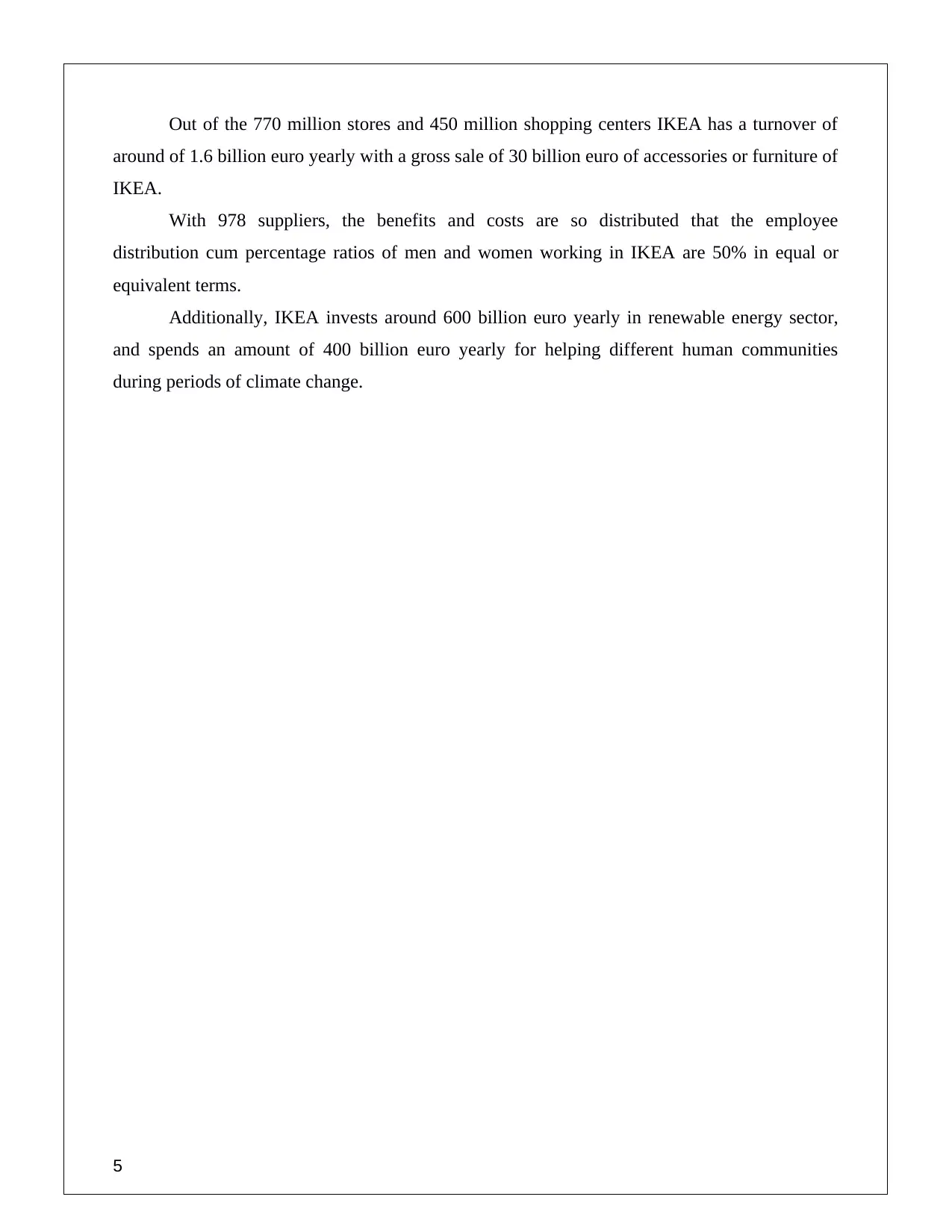
Out of the 770 million stores and 450 million shopping centers IKEA has a turnover of
around of 1.6 billion euro yearly with a gross sale of 30 billion euro of accessories or furniture of
IKEA.
With 978 suppliers, the benefits and costs are so distributed that the employee
distribution cum percentage ratios of men and women working in IKEA are 50% in equal or
equivalent terms.
Additionally, IKEA invests around 600 billion euro yearly in renewable energy sector,
and spends an amount of 400 billion euro yearly for helping different human communities
during periods of climate change.
5
around of 1.6 billion euro yearly with a gross sale of 30 billion euro of accessories or furniture of
IKEA.
With 978 suppliers, the benefits and costs are so distributed that the employee
distribution cum percentage ratios of men and women working in IKEA are 50% in equal or
equivalent terms.
Additionally, IKEA invests around 600 billion euro yearly in renewable energy sector,
and spends an amount of 400 billion euro yearly for helping different human communities
during periods of climate change.
5

Task 2 Ability to understand concepts of segmentation, targeting and
positioning
2.1 Macro and micro environment factors which influence marketing
decisions
The macro and micro environment factors which influence the marketing decisions of
business organizations like that of IKEA are that of SWOT and PESTLE analysis which
influence market decisions in the following manner:
SWOT (Strength, Weaknesses, Opportunities, and Threat) analysis of IKEA can be defined in
terms of merits, demerits, opportunities or privileges of IKEA and threats or challenges faced by
IKEA in differential amounts (Hutt and Sped, 2012, p.123).
The strengths of IKEA are that it produces a wide variety of accessories and home
appliances which earn it a huge turnover of around 500 billion euro yearly in sound mechanism
or manner hence the ability to earn a consistent amount of profits is a valid criteria of IKEA
group of organization.
The demerits are that though it has a huge business infrastructure yet it lacks effective
number of managers and team leaders to maintain the large scale based business organization
process running in smooth and tandem and tandem manner.
The opportunities or privileges based facilities of IKEA are that they are multi sectored
and multi placed and so even though losses are made in one part of organization there are still
essence of profits in other sectors in different locations of organizations and hence the losses are
counterbalanced by profits earned in various sectors or processes of business based placements
in varieties of locations.
The threats are unforeseen business challenges witnessed and being cropped up in
variety of circumstances and scenarios of business processes in IKEA.
Now let us discuss about the PESTLE analysis of IKEA or the political, economical, social,
technological, legal and environmental factors influencing the organizational structure of IKEA
and the social and business environment of IKEA in differential amounts or terms.
The political factors are that there are different political barriers like that of differential policies
based programmers of government in different locations and placements of IKEA (Yeshin, 2012,
p.33). For example, change in political systems causes decrease in tax policy on furniture items
6
positioning
2.1 Macro and micro environment factors which influence marketing
decisions
The macro and micro environment factors which influence the marketing decisions of
business organizations like that of IKEA are that of SWOT and PESTLE analysis which
influence market decisions in the following manner:
SWOT (Strength, Weaknesses, Opportunities, and Threat) analysis of IKEA can be defined in
terms of merits, demerits, opportunities or privileges of IKEA and threats or challenges faced by
IKEA in differential amounts (Hutt and Sped, 2012, p.123).
The strengths of IKEA are that it produces a wide variety of accessories and home
appliances which earn it a huge turnover of around 500 billion euro yearly in sound mechanism
or manner hence the ability to earn a consistent amount of profits is a valid criteria of IKEA
group of organization.
The demerits are that though it has a huge business infrastructure yet it lacks effective
number of managers and team leaders to maintain the large scale based business organization
process running in smooth and tandem and tandem manner.
The opportunities or privileges based facilities of IKEA are that they are multi sectored
and multi placed and so even though losses are made in one part of organization there are still
essence of profits in other sectors in different locations of organizations and hence the losses are
counterbalanced by profits earned in various sectors or processes of business based placements
in varieties of locations.
The threats are unforeseen business challenges witnessed and being cropped up in
variety of circumstances and scenarios of business processes in IKEA.
Now let us discuss about the PESTLE analysis of IKEA or the political, economical, social,
technological, legal and environmental factors influencing the organizational structure of IKEA
and the social and business environment of IKEA in differential amounts or terms.
The political factors are that there are different political barriers like that of differential policies
based programmers of government in different locations and placements of IKEA (Yeshin, 2012,
p.33). For example, change in political systems causes decrease in tax policy on furniture items
6
⊘ This is a preview!⊘
Do you want full access?
Subscribe today to unlock all pages.

Trusted by 1+ million students worldwide

which help IKEA to achieve huge profitability and gain customer strength. For this, IKEA
should expand its business operations where the government are more stable.
The economic factors and the social factors are different ethics and norms of society
which influence the atmosphere of business of IKEA in differential, patterns affecting its overall
turnover and total sales of about triple hundred billion euro being earned by the company of
IKEA in varied amounts. IKEA is operated in UK where the economy growth rate are increasing
on annual basis therefore it directly positively impact on the buying power of people due to
which they can afford more to buy furniture items with their disposable incomes. This will
increases the profitability of IKEA.
The business output and environment of IKEA is also affected by the legal and
environmental factors which also influence the business of IKEA being carried and
channelized by IKEA through the 700 billion stores of the company in different parts of Asian
and sub-Asian world. Contributing towards CSR activities increases the brand image of IKEA
which in results attracts the loyalty of maximum number of customers. It directly positively
impact on the profitability and sustainability of company.
2.2 Segmentation criteria to be used in different markets
The segmentation of markets of organization of IKEA should be as follows;
Measurability: The market of IKEA is segmented in terms of business performance
measured in terms of varying amounts of GDP (gross domestic product) and total sales revenue
of IKEA in different scenarios and circumstances of marketing business process based segments
of marketing business of IKEA. It implies that the company should target the market where they
receive large number of customers preferred to buy their products. For example, IKEA should
targeted urban areas where they receive more demand from people of their furniture product.
This will increases the performance level and profitability of company.
Sustainability: The market of IKEA is segmented in terms of sustainability criterion of
business organization of IKEA. It depends on the nature of durability and the production
techniques of IKEA’s products or services based on the same that the nature of segmentation of
sustainable business of IKEA is being carried out in acuter terms (Wang et al. 2013, p.37).
IKEA should target the market where the spending power of people are high. For example, high
and middle income group must be targeted by IKEA as they are more capable in buying their
products, This will automatically increases the growth and performance level of company.
7
should expand its business operations where the government are more stable.
The economic factors and the social factors are different ethics and norms of society
which influence the atmosphere of business of IKEA in differential, patterns affecting its overall
turnover and total sales of about triple hundred billion euro being earned by the company of
IKEA in varied amounts. IKEA is operated in UK where the economy growth rate are increasing
on annual basis therefore it directly positively impact on the buying power of people due to
which they can afford more to buy furniture items with their disposable incomes. This will
increases the profitability of IKEA.
The business output and environment of IKEA is also affected by the legal and
environmental factors which also influence the business of IKEA being carried and
channelized by IKEA through the 700 billion stores of the company in different parts of Asian
and sub-Asian world. Contributing towards CSR activities increases the brand image of IKEA
which in results attracts the loyalty of maximum number of customers. It directly positively
impact on the profitability and sustainability of company.
2.2 Segmentation criteria to be used in different markets
The segmentation of markets of organization of IKEA should be as follows;
Measurability: The market of IKEA is segmented in terms of business performance
measured in terms of varying amounts of GDP (gross domestic product) and total sales revenue
of IKEA in different scenarios and circumstances of marketing business process based segments
of marketing business of IKEA. It implies that the company should target the market where they
receive large number of customers preferred to buy their products. For example, IKEA should
targeted urban areas where they receive more demand from people of their furniture product.
This will increases the performance level and profitability of company.
Sustainability: The market of IKEA is segmented in terms of sustainability criterion of
business organization of IKEA. It depends on the nature of durability and the production
techniques of IKEA’s products or services based on the same that the nature of segmentation of
sustainable business of IKEA is being carried out in acuter terms (Wang et al. 2013, p.37).
IKEA should target the market where the spending power of people are high. For example, high
and middle income group must be targeted by IKEA as they are more capable in buying their
products, This will automatically increases the growth and performance level of company.
7
Paraphrase This Document
Need a fresh take? Get an instant paraphrase of this document with our AI Paraphraser
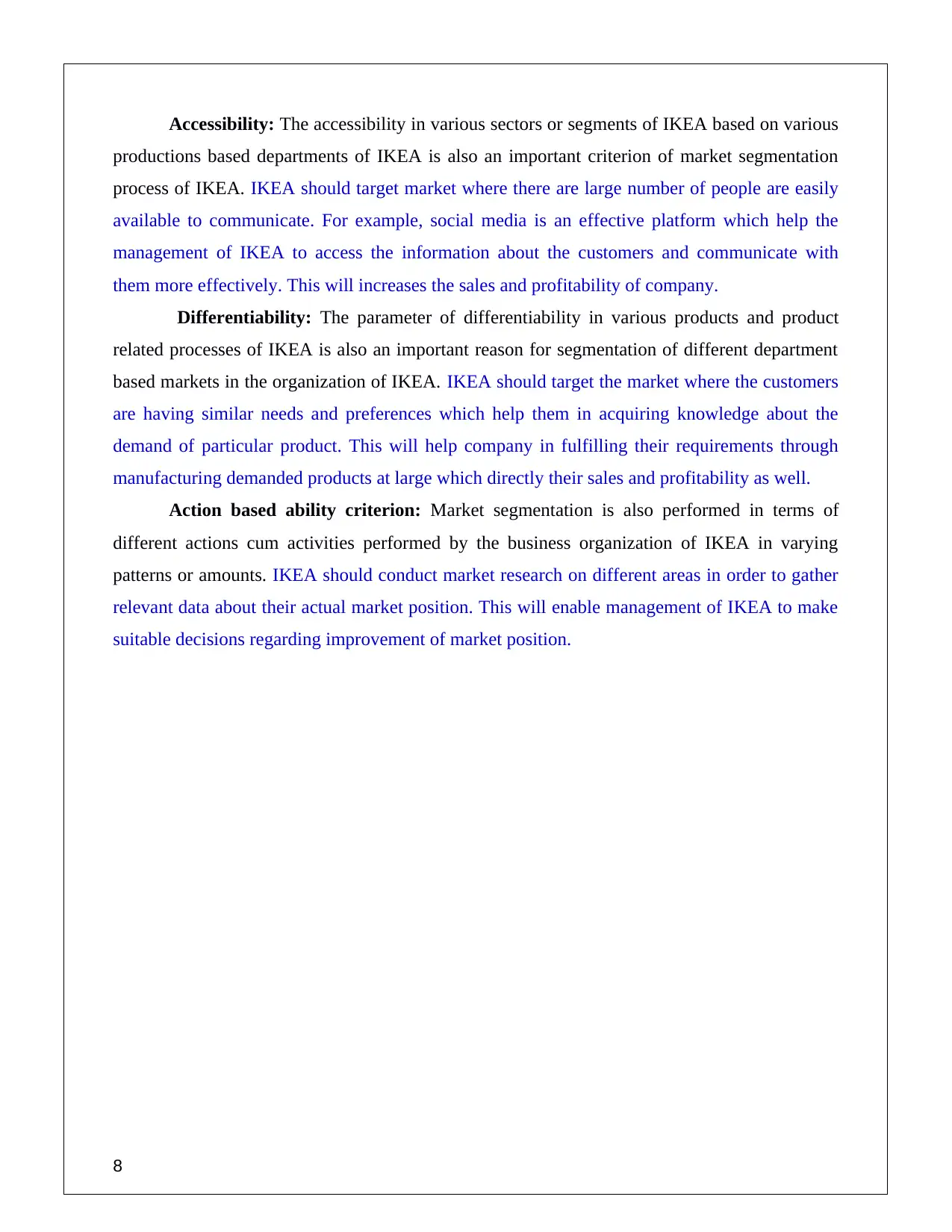
Accessibility: The accessibility in various sectors or segments of IKEA based on various
productions based departments of IKEA is also an important criterion of market segmentation
process of IKEA. IKEA should target market where there are large number of people are easily
available to communicate. For example, social media is an effective platform which help the
management of IKEA to access the information about the customers and communicate with
them more effectively. This will increases the sales and profitability of company.
Differentiability: The parameter of differentiability in various products and product
related processes of IKEA is also an important reason for segmentation of different department
based markets in the organization of IKEA. IKEA should target the market where the customers
are having similar needs and preferences which help them in acquiring knowledge about the
demand of particular product. This will help company in fulfilling their requirements through
manufacturing demanded products at large which directly their sales and profitability as well.
Action based ability criterion: Market segmentation is also performed in terms of
different actions cum activities performed by the business organization of IKEA in varying
patterns or amounts. IKEA should conduct market research on different areas in order to gather
relevant data about their actual market position. This will enable management of IKEA to make
suitable decisions regarding improvement of market position.
8
productions based departments of IKEA is also an important criterion of market segmentation
process of IKEA. IKEA should target market where there are large number of people are easily
available to communicate. For example, social media is an effective platform which help the
management of IKEA to access the information about the customers and communicate with
them more effectively. This will increases the sales and profitability of company.
Differentiability: The parameter of differentiability in various products and product
related processes of IKEA is also an important reason for segmentation of different department
based markets in the organization of IKEA. IKEA should target the market where the customers
are having similar needs and preferences which help them in acquiring knowledge about the
demand of particular product. This will help company in fulfilling their requirements through
manufacturing demanded products at large which directly their sales and profitability as well.
Action based ability criterion: Market segmentation is also performed in terms of
different actions cum activities performed by the business organization of IKEA in varying
patterns or amounts. IKEA should conduct market research on different areas in order to gather
relevant data about their actual market position. This will enable management of IKEA to make
suitable decisions regarding improvement of market position.
8
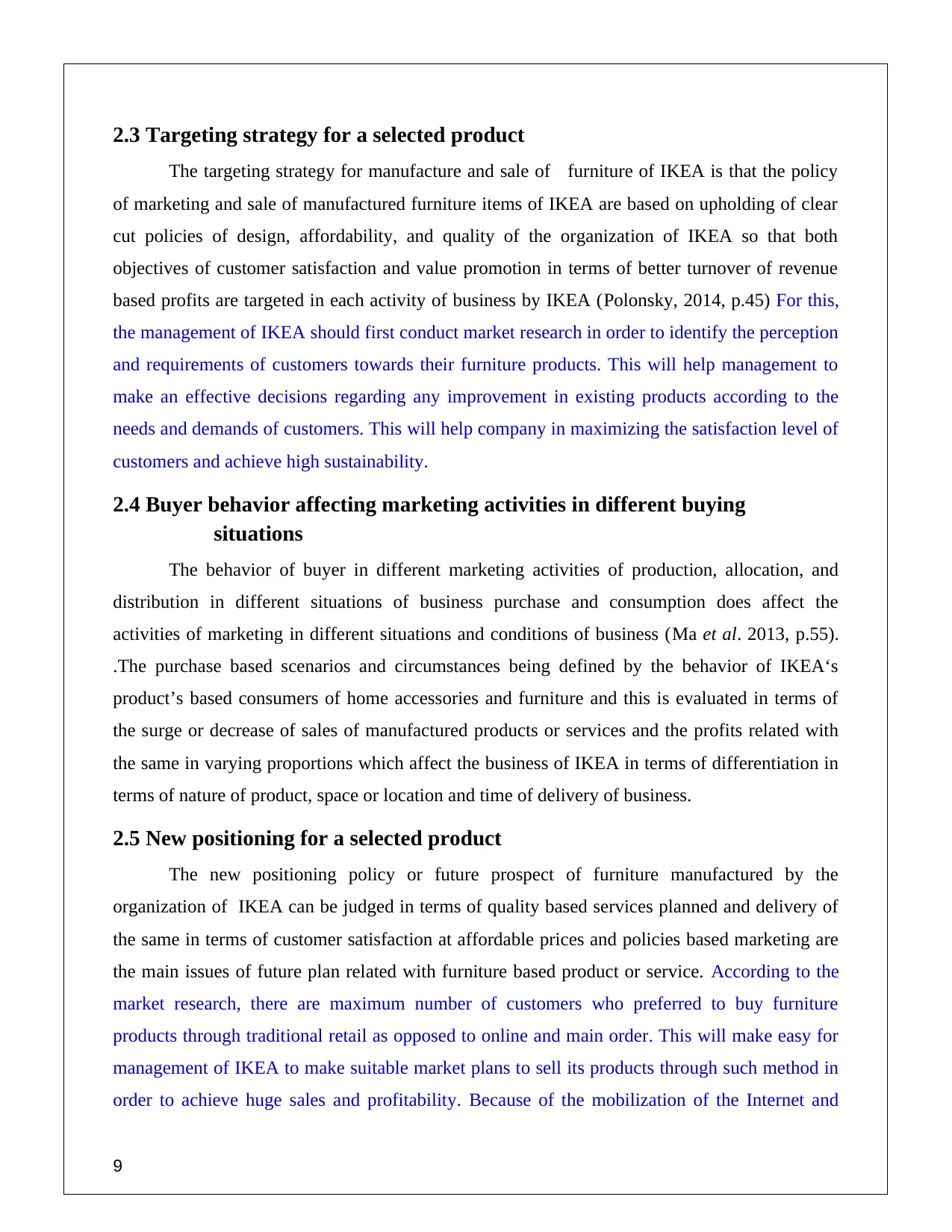
2.3 Targeting strategy for a selected product
The targeting strategy for manufacture and sale of furniture of IKEA is that the policy
of marketing and sale of manufactured furniture items of IKEA are based on upholding of clear
cut policies of design, affordability, and quality of the organization of IKEA so that both
objectives of customer satisfaction and value promotion in terms of better turnover of revenue
based profits are targeted in each activity of business by IKEA (Polonsky, 2014, p.45) For this,
the management of IKEA should first conduct market research in order to identify the perception
and requirements of customers towards their furniture products. This will help management to
make an effective decisions regarding any improvement in existing products according to the
needs and demands of customers. This will help company in maximizing the satisfaction level of
customers and achieve high sustainability.
2.4 Buyer behavior affecting marketing activities in different buying
situations
The behavior of buyer in different marketing activities of production, allocation, and
distribution in different situations of business purchase and consumption does affect the
activities of marketing in different situations and conditions of business (Ma et al. 2013, p.55).
.The purchase based scenarios and circumstances being defined by the behavior of IKEA‘s
product’s based consumers of home accessories and furniture and this is evaluated in terms of
the surge or decrease of sales of manufactured products or services and the profits related with
the same in varying proportions which affect the business of IKEA in terms of differentiation in
terms of nature of product, space or location and time of delivery of business.
2.5 New positioning for a selected product
The new positioning policy or future prospect of furniture manufactured by the
organization of IKEA can be judged in terms of quality based services planned and delivery of
the same in terms of customer satisfaction at affordable prices and policies based marketing are
the main issues of future plan related with furniture based product or service. According to the
market research, there are maximum number of customers who preferred to buy furniture
products through traditional retail as opposed to online and main order. This will make easy for
management of IKEA to make suitable market plans to sell its products through such method in
order to achieve huge sales and profitability. Because of the mobilization of the Internet and
9
The targeting strategy for manufacture and sale of furniture of IKEA is that the policy
of marketing and sale of manufactured furniture items of IKEA are based on upholding of clear
cut policies of design, affordability, and quality of the organization of IKEA so that both
objectives of customer satisfaction and value promotion in terms of better turnover of revenue
based profits are targeted in each activity of business by IKEA (Polonsky, 2014, p.45) For this,
the management of IKEA should first conduct market research in order to identify the perception
and requirements of customers towards their furniture products. This will help management to
make an effective decisions regarding any improvement in existing products according to the
needs and demands of customers. This will help company in maximizing the satisfaction level of
customers and achieve high sustainability.
2.4 Buyer behavior affecting marketing activities in different buying
situations
The behavior of buyer in different marketing activities of production, allocation, and
distribution in different situations of business purchase and consumption does affect the
activities of marketing in different situations and conditions of business (Ma et al. 2013, p.55).
.The purchase based scenarios and circumstances being defined by the behavior of IKEA‘s
product’s based consumers of home accessories and furniture and this is evaluated in terms of
the surge or decrease of sales of manufactured products or services and the profits related with
the same in varying proportions which affect the business of IKEA in terms of differentiation in
terms of nature of product, space or location and time of delivery of business.
2.5 New positioning for a selected product
The new positioning policy or future prospect of furniture manufactured by the
organization of IKEA can be judged in terms of quality based services planned and delivery of
the same in terms of customer satisfaction at affordable prices and policies based marketing are
the main issues of future plan related with furniture based product or service. According to the
market research, there are maximum number of customers who preferred to buy furniture
products through traditional retail as opposed to online and main order. This will make easy for
management of IKEA to make suitable market plans to sell its products through such method in
order to achieve huge sales and profitability. Because of the mobilization of the Internet and
9
⊘ This is a preview!⊘
Do you want full access?
Subscribe today to unlock all pages.

Trusted by 1+ million students worldwide
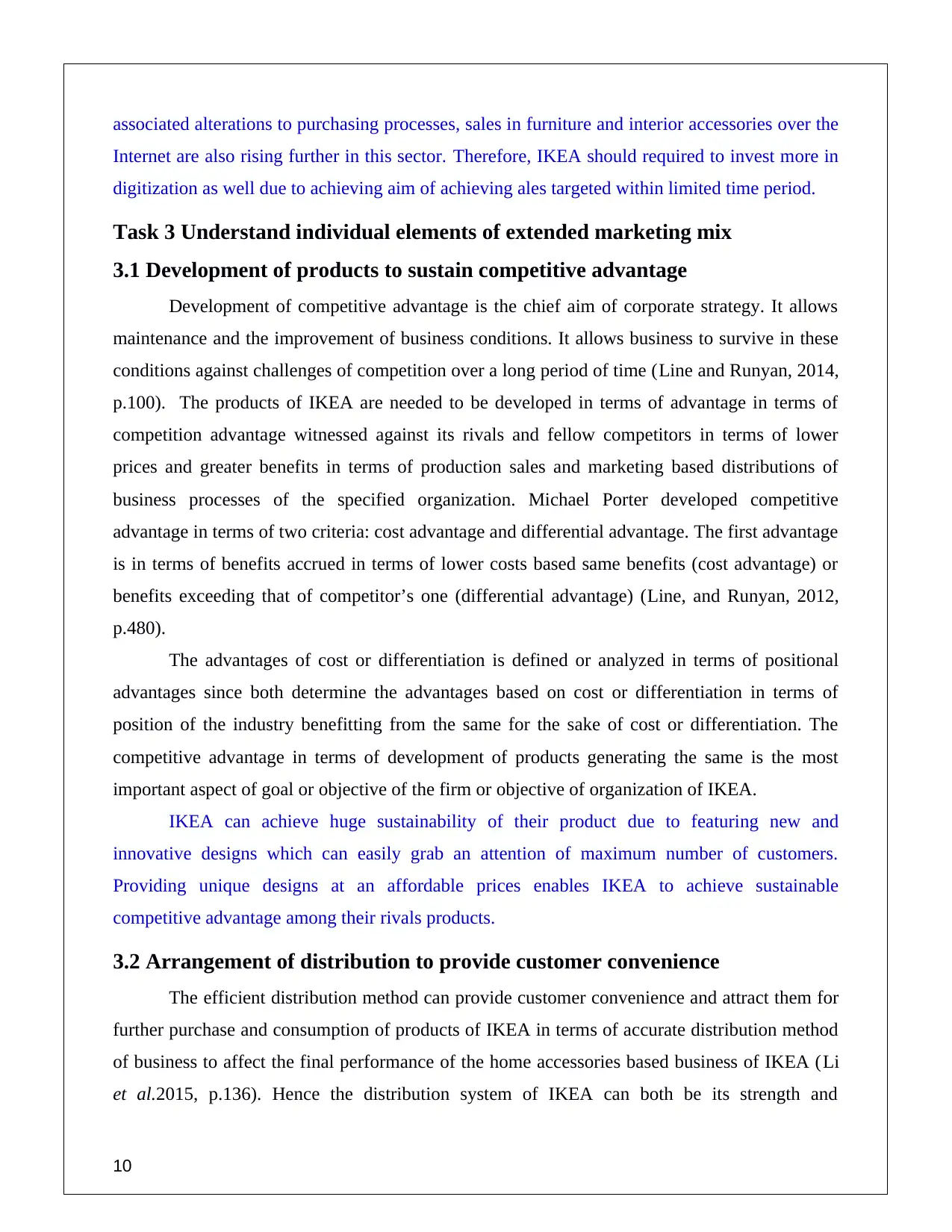
associated alterations to purchasing processes, sales in furniture and interior accessories over the
Internet are also rising further in this sector. Therefore, IKEA should required to invest more in
digitization as well due to achieving aim of achieving ales targeted within limited time period.
Task 3 Understand individual elements of extended marketing mix
3.1 Development of products to sustain competitive advantage
Development of competitive advantage is the chief aim of corporate strategy. It allows
maintenance and the improvement of business conditions. It allows business to survive in these
conditions against challenges of competition over a long period of time (Line and Runyan, 2014,
p.100). The products of IKEA are needed to be developed in terms of advantage in terms of
competition advantage witnessed against its rivals and fellow competitors in terms of lower
prices and greater benefits in terms of production sales and marketing based distributions of
business processes of the specified organization. Michael Porter developed competitive
advantage in terms of two criteria: cost advantage and differential advantage. The first advantage
is in terms of benefits accrued in terms of lower costs based same benefits (cost advantage) or
benefits exceeding that of competitor’s one (differential advantage) (Line, and Runyan, 2012,
p.480).
The advantages of cost or differentiation is defined or analyzed in terms of positional
advantages since both determine the advantages based on cost or differentiation in terms of
position of the industry benefitting from the same for the sake of cost or differentiation. The
competitive advantage in terms of development of products generating the same is the most
important aspect of goal or objective of the firm or objective of organization of IKEA.
IKEA can achieve huge sustainability of their product due to featuring new and
innovative designs which can easily grab an attention of maximum number of customers.
Providing unique designs at an affordable prices enables IKEA to achieve sustainable
competitive advantage among their rivals products.
3.2 Arrangement of distribution to provide customer convenience
The efficient distribution method can provide customer convenience and attract them for
further purchase and consumption of products of IKEA in terms of accurate distribution method
of business to affect the final performance of the home accessories based business of IKEA (Li
et al.2015, p.136). Hence the distribution system of IKEA can both be its strength and
10
Internet are also rising further in this sector. Therefore, IKEA should required to invest more in
digitization as well due to achieving aim of achieving ales targeted within limited time period.
Task 3 Understand individual elements of extended marketing mix
3.1 Development of products to sustain competitive advantage
Development of competitive advantage is the chief aim of corporate strategy. It allows
maintenance and the improvement of business conditions. It allows business to survive in these
conditions against challenges of competition over a long period of time (Line and Runyan, 2014,
p.100). The products of IKEA are needed to be developed in terms of advantage in terms of
competition advantage witnessed against its rivals and fellow competitors in terms of lower
prices and greater benefits in terms of production sales and marketing based distributions of
business processes of the specified organization. Michael Porter developed competitive
advantage in terms of two criteria: cost advantage and differential advantage. The first advantage
is in terms of benefits accrued in terms of lower costs based same benefits (cost advantage) or
benefits exceeding that of competitor’s one (differential advantage) (Line, and Runyan, 2012,
p.480).
The advantages of cost or differentiation is defined or analyzed in terms of positional
advantages since both determine the advantages based on cost or differentiation in terms of
position of the industry benefitting from the same for the sake of cost or differentiation. The
competitive advantage in terms of development of products generating the same is the most
important aspect of goal or objective of the firm or objective of organization of IKEA.
IKEA can achieve huge sustainability of their product due to featuring new and
innovative designs which can easily grab an attention of maximum number of customers.
Providing unique designs at an affordable prices enables IKEA to achieve sustainable
competitive advantage among their rivals products.
3.2 Arrangement of distribution to provide customer convenience
The efficient distribution method can provide customer convenience and attract them for
further purchase and consumption of products of IKEA in terms of accurate distribution method
of business to affect the final performance of the home accessories based business of IKEA (Li
et al.2015, p.136). Hence the distribution system of IKEA can both be its strength and
10
Paraphrase This Document
Need a fresh take? Get an instant paraphrase of this document with our AI Paraphraser

weaknesses in terms of the intensity of attracting the customer based business of IKEA.
Consumer’s need based criteria of business is the most vital factor affecting distribution pattern
of business in IKEA influencing customer convenience and satisfaction. The main objective of
the distribution based criteria is to develop pricing strategies more profitably by deriving more
values in terms of profits rather than by promoting new sales of business (Leeflang et al. 2014,
p.10). Therefore strategies based on distribution pa rameters to affect customer attraction and
inclinations towards purchase of new products of IKEA are either based on the IDEA of
promotion of sales objectives or long -term profitability based promotion plans of business.
IKEA should make careful decision regarding selection of distribution channel as nowadays
customers prefer to receive products on time at preferred locations. For this, sophisticated
technology must required to adopt in order to decrease their cost of operations as well as
increase loyalty of customers.
3.3 Setting up of prices to reflect marketing conditions and objectives
The prices set reflect marketing conditions and business objectives of IKEA in terms of
the differential impacts or policies of cost -based pricing based policies. Value and prices are
customer’s based positions in terms of different marketing conditions and objectives of IKEA
based organizations’ activities cum actions of business monitoring and implementation (Kotler et
al. 2015, p.134). The pricing strategy of IKEA is based on the level of competition faced by it
and once the prices are strategized the determination of marketing objectives and conditions of
business are duly met or determined.
Charging of lower prices for higher sale of products to meet the objective of sales
maximization or charging of higher prices to meet the objectives of profit maximization are the
main goals of the organization of IKEA (Hennig-Thurau, 2013, p.240). The prices are set in a
way to increase the quality of the manufactured products or services but to increase the
improvement of marketing conditions of IKEA (Kotler, 2015, p.120). The arrival of new
entrants or their exits does influence the setting up of new mechanisms of pricing strategies of
IKEA in terms of differential market conditions of business based on competition in terms of
various objectives or aims of IKEA based organization.
11
Consumer’s need based criteria of business is the most vital factor affecting distribution pattern
of business in IKEA influencing customer convenience and satisfaction. The main objective of
the distribution based criteria is to develop pricing strategies more profitably by deriving more
values in terms of profits rather than by promoting new sales of business (Leeflang et al. 2014,
p.10). Therefore strategies based on distribution pa rameters to affect customer attraction and
inclinations towards purchase of new products of IKEA are either based on the IDEA of
promotion of sales objectives or long -term profitability based promotion plans of business.
IKEA should make careful decision regarding selection of distribution channel as nowadays
customers prefer to receive products on time at preferred locations. For this, sophisticated
technology must required to adopt in order to decrease their cost of operations as well as
increase loyalty of customers.
3.3 Setting up of prices to reflect marketing conditions and objectives
The prices set reflect marketing conditions and business objectives of IKEA in terms of
the differential impacts or policies of cost -based pricing based policies. Value and prices are
customer’s based positions in terms of different marketing conditions and objectives of IKEA
based organizations’ activities cum actions of business monitoring and implementation (Kotler et
al. 2015, p.134). The pricing strategy of IKEA is based on the level of competition faced by it
and once the prices are strategized the determination of marketing objectives and conditions of
business are duly met or determined.
Charging of lower prices for higher sale of products to meet the objective of sales
maximization or charging of higher prices to meet the objectives of profit maximization are the
main goals of the organization of IKEA (Hennig-Thurau, 2013, p.240). The prices are set in a
way to increase the quality of the manufactured products or services but to increase the
improvement of marketing conditions of IKEA (Kotler, 2015, p.120). The arrival of new
entrants or their exits does influence the setting up of new mechanisms of pricing strategies of
IKEA in terms of differential market conditions of business based on competition in terms of
various objectives or aims of IKEA based organization.
11
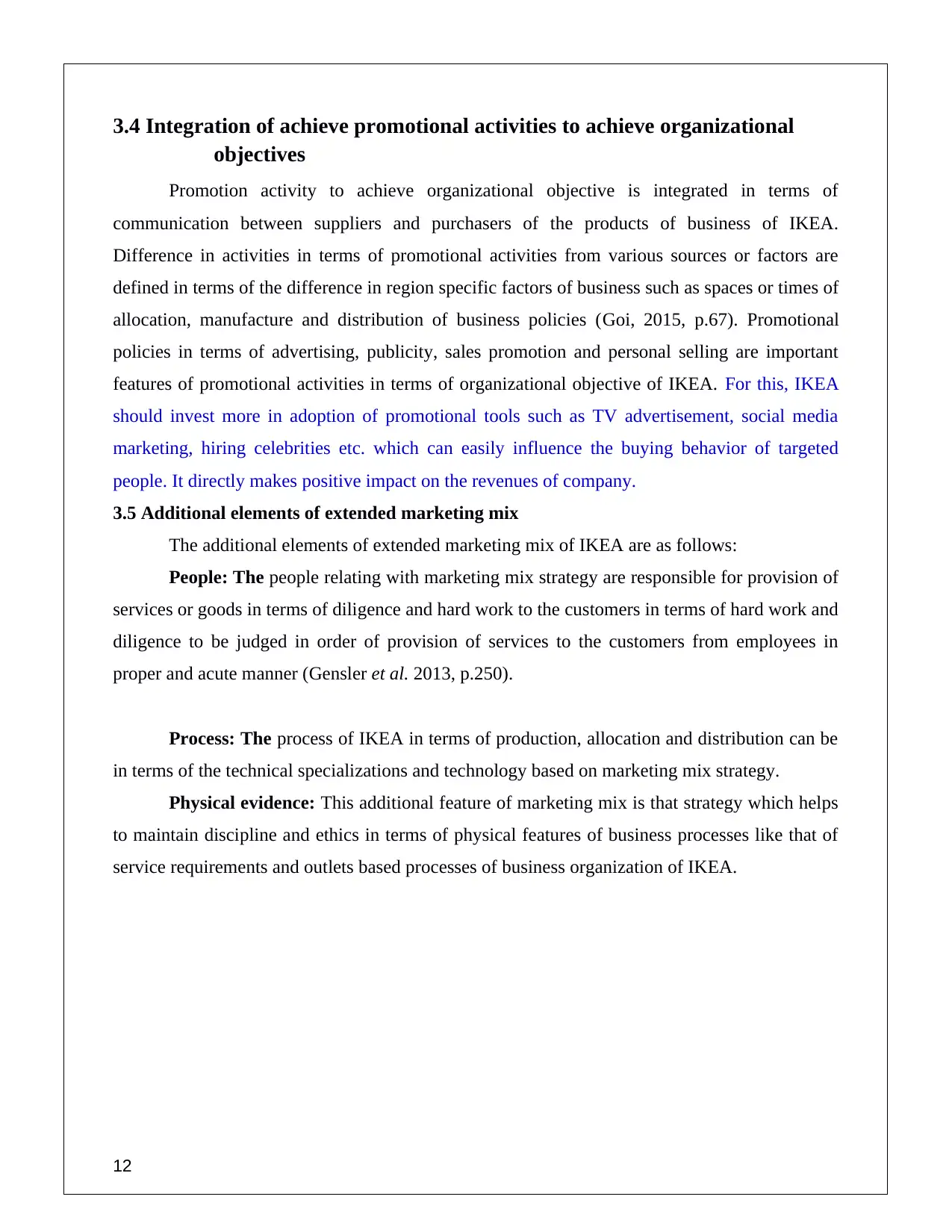
3.4 Integration of achieve promotional activities to achieve organizational
objectives
Promotion activity to achieve organizational objective is integrated in terms of
communication between suppliers and purchasers of the products of business of IKEA.
Difference in activities in terms of promotional activities from various sources or factors are
defined in terms of the difference in region specific factors of business such as spaces or times of
allocation, manufacture and distribution of business policies (Goi, 2015, p.67). Promotional
policies in terms of advertising, publicity, sales promotion and personal selling are important
features of promotional activities in terms of organizational objective of IKEA. For this, IKEA
should invest more in adoption of promotional tools such as TV advertisement, social media
marketing, hiring celebrities etc. which can easily influence the buying behavior of targeted
people. It directly makes positive impact on the revenues of company.
3.5 Additional elements of extended marketing mix
The additional elements of extended marketing mix of IKEA are as follows:
People: The people relating with marketing mix strategy are responsible for provision of
services or goods in terms of diligence and hard work to the customers in terms of hard work and
diligence to be judged in order of provision of services to the customers from employees in
proper and acute manner (Gensler et al. 2013, p.250).
Process: The process of IKEA in terms of production, allocation and distribution can be
in terms of the technical specializations and technology based on marketing mix strategy.
Physical evidence: This additional feature of marketing mix is that strategy which helps
to maintain discipline and ethics in terms of physical features of business processes like that of
service requirements and outlets based processes of business organization of IKEA.
12
objectives
Promotion activity to achieve organizational objective is integrated in terms of
communication between suppliers and purchasers of the products of business of IKEA.
Difference in activities in terms of promotional activities from various sources or factors are
defined in terms of the difference in region specific factors of business such as spaces or times of
allocation, manufacture and distribution of business policies (Goi, 2015, p.67). Promotional
policies in terms of advertising, publicity, sales promotion and personal selling are important
features of promotional activities in terms of organizational objective of IKEA. For this, IKEA
should invest more in adoption of promotional tools such as TV advertisement, social media
marketing, hiring celebrities etc. which can easily influence the buying behavior of targeted
people. It directly makes positive impact on the revenues of company.
3.5 Additional elements of extended marketing mix
The additional elements of extended marketing mix of IKEA are as follows:
People: The people relating with marketing mix strategy are responsible for provision of
services or goods in terms of diligence and hard work to the customers in terms of hard work and
diligence to be judged in order of provision of services to the customers from employees in
proper and acute manner (Gensler et al. 2013, p.250).
Process: The process of IKEA in terms of production, allocation and distribution can be
in terms of the technical specializations and technology based on marketing mix strategy.
Physical evidence: This additional feature of marketing mix is that strategy which helps
to maintain discipline and ethics in terms of physical features of business processes like that of
service requirements and outlets based processes of business organization of IKEA.
12
⊘ This is a preview!⊘
Do you want full access?
Subscribe today to unlock all pages.

Trusted by 1+ million students worldwide
1 out of 17
Related Documents
Your All-in-One AI-Powered Toolkit for Academic Success.
+13062052269
info@desklib.com
Available 24*7 on WhatsApp / Email
![[object Object]](/_next/static/media/star-bottom.7253800d.svg)
Unlock your academic potential
Copyright © 2020–2025 A2Z Services. All Rights Reserved. Developed and managed by ZUCOL.





